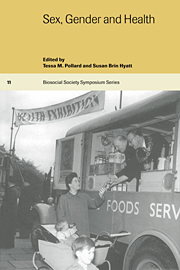Book contents
- Frontmatter
- Contents
- List of contributors
- Preface
- 1 Sex, gender and health: integrating biological and social perspectives
- 2 Parental manipulation of postnatal survival and well-being: are parental sex preferences adaptive?
- 3 Gender bias in South Asia: effects on child growth and nutritional status
- 4 Sex, gender and cardiovascular disease
- 5 Social meanings and sexual bodies: gender, sexuality and barriers to women's health care
- 6 Poverty and the medicalisation of motherhood
- 7 The vanishing woman: gender and population health
- 8 Agency, opposition and resistance: a systemic approach to psychological illness in sub-dominant groups
- Glossary
- Index
5 - Social meanings and sexual bodies: gender, sexuality and barriers to women's health care
Published online by Cambridge University Press: 07 December 2009
- Frontmatter
- Contents
- List of contributors
- Preface
- 1 Sex, gender and health: integrating biological and social perspectives
- 2 Parental manipulation of postnatal survival and well-being: are parental sex preferences adaptive?
- 3 Gender bias in South Asia: effects on child growth and nutritional status
- 4 Sex, gender and cardiovascular disease
- 5 Social meanings and sexual bodies: gender, sexuality and barriers to women's health care
- 6 Poverty and the medicalisation of motherhood
- 7 The vanishing woman: gender and population health
- 8 Agency, opposition and resistance: a systemic approach to psychological illness in sub-dominant groups
- Glossary
- Index
Summary
In this chapter I explore the impact of cultural constructions of gender and sexuality on women's and men's health. Drawing on work conducted in subsistence, industrialising and industrialised societies, particularly with women, I illustrate the ways in which sexual, reproductive and other health problems are influenced by ideas about and relations of gender and sexuality. Despite differences in social, cultural and economic contexts, women everywhere are subordinate to men to some degree. Their sexuality is controlled and their social value is tied to their reproductive abilities, both in terms of having children and maintaining the household. These factors influence women's abilities to care for their bodies and to control their fertility. The sexual meanings ascribed to women's bodies influence popular interpretations of the signs and symptoms of health and illness and affect help-seeking behaviour and access to health services and treatment, especially for ailments which might be construed as sexual. Gender also affects men's access to and use of health services in relation to sexual and urinary tract infections in many communities and for that reason, I include some discussion of men's as well as women's health in this chapter.
The social context of health and illness
While this chapter focuses on the social experiences of illness, care and outcome, at the outset it is important to note that the risk of infection and disease occurs through a combination of biological, social and structural factors. Changes to local ecologies by development programmes, patterns of population movement and settlement, water and sanitation, all affect the prevalence of vectors and microbes and, hence, influence the potential distribution of infectious disease for both women and men.
- Type
- Chapter
- Information
- Sex, Gender and Health , pp. 75 - 93Publisher: Cambridge University PressPrint publication year: 1999



